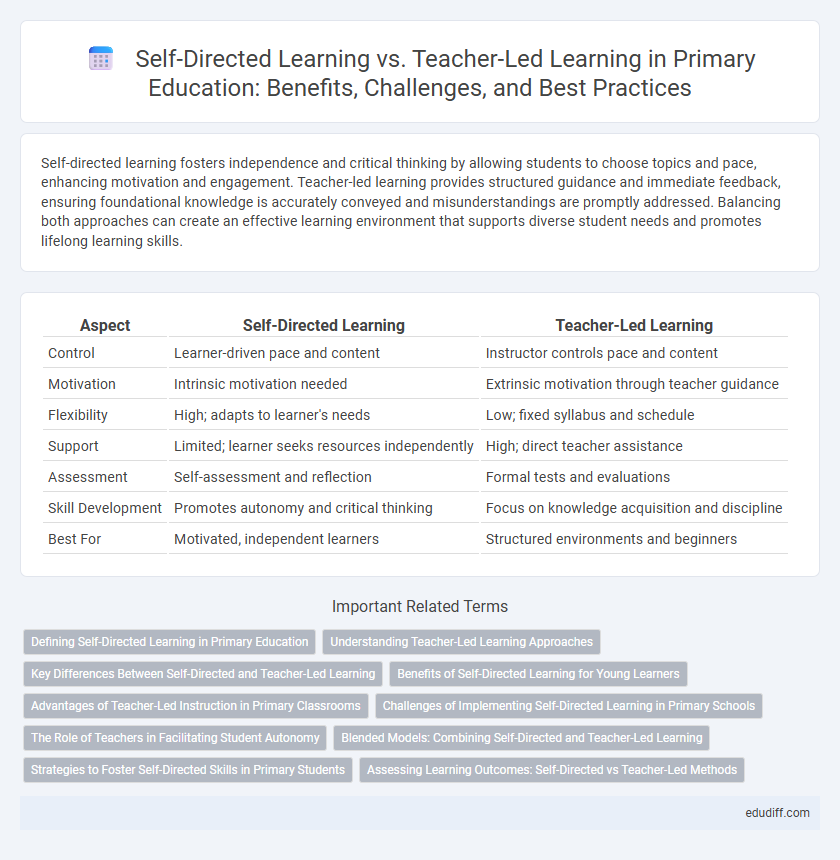Self-directed learning fosters independence and critical thinking by allowing students to choose topics and pace, enhancing motivation and engagement. Teacher-led learning provides structured guidance and immediate feedback, ensuring foundational knowledge is accurately conveyed and misunderstandings are promptly addressed. Balancing both approaches can create an effective learning environment that supports diverse student needs and promotes lifelong learning skills.
Table of Comparison
| Aspect | Self-Directed Learning | Teacher-Led Learning |
|---|---|---|
| Control | Learner-driven pace and content | Instructor controls pace and content |
| Motivation | Intrinsic motivation needed | Extrinsic motivation through teacher guidance |
| Flexibility | High; adapts to learner's needs | Low; fixed syllabus and schedule |
| Support | Limited; learner seeks resources independently | High; direct teacher assistance |
| Assessment | Self-assessment and reflection | Formal tests and evaluations |
| Skill Development | Promotes autonomy and critical thinking | Focus on knowledge acquisition and discipline |
| Best For | Motivated, independent learners | Structured environments and beginners |
Defining Self-Directed Learning in Primary Education
Self-directed learning in primary education refers to young learners taking initiative, setting personal learning goals, and independently seeking resources to understand new concepts. This approach encourages critical thinking, fosters intrinsic motivation, and enhances problem-solving skills by allowing students to control their learning pace and pathways. It contrasts with teacher-led learning by emphasizing autonomy and personalized engagement in foundational educational stages.
Understanding Teacher-Led Learning Approaches
Teacher-led learning approaches emphasize structured guidance where instructors direct the educational process through lectures, explanations, and demonstrations, ensuring clear alignment with curriculum standards. This method fosters a controlled environment conducive to systematic knowledge acquisition and immediate feedback on student performance. By leveraging expert insights and organized lesson plans, teacher-led learning optimizes comprehension and retention in primary education settings.
Key Differences Between Self-Directed and Teacher-Led Learning
Self-directed learning emphasizes learner autonomy, allowing students to set goals, choose resources, and pace their study, fostering critical thinking and intrinsic motivation. Teacher-led learning relies on structured guidance, with educators designing curriculum, delivering content, and assessing progress to ensure compliance with educational standards. Key differences lie in the control over learning processes, adaptability to individual needs, and development of self-regulation skills essential for lifelong learning success.
Benefits of Self-Directed Learning for Young Learners
Self-directed learning empowers young learners by fostering critical thinking, independence, and intrinsic motivation, leading to deeper engagement and retention of knowledge. It enhances problem-solving skills and adaptability, equipping children to navigate diverse learning environments and challenges effectively. Personalized pacing and choice in self-directed learning promote confidence and a lifelong passion for education.
Advantages of Teacher-Led Instruction in Primary Classrooms
Teacher-led instruction in primary classrooms provides structured guidance essential for foundational skill development in literacy and numeracy. It ensures curriculum alignment and consistent assessment, promoting measurable learning outcomes and accountability. Skilled teachers can adapt instruction based on formative feedback, enhancing student engagement and addressing diverse learning needs effectively.
Challenges of Implementing Self-Directed Learning in Primary Schools
Implementing self-directed learning in primary schools faces challenges such as limited student motivation, insufficient metacognitive skills, and varying levels of parental support, which can hinder consistent engagement. Teachers often struggle to balance curriculum requirements with fostering autonomy, leading to potential gaps in foundational knowledge acquisition. Resource limitations and a lack of professional development further complicate effective implementation and monitoring of self-directed learning progress at the primary level.
The Role of Teachers in Facilitating Student Autonomy
Teachers play a crucial role in facilitating student autonomy by providing guidance and resources that encourage independent thinking and problem-solving. They create structured environments where students can set goals, monitor progress, and reflect on learning outcomes, fostering self-directed learning skills. Effective teacher support balances direction with freedom, enabling learners to build confidence and intrinsic motivation for lifelong education.
Blended Models: Combining Self-Directed and Teacher-Led Learning
Blended models integrate self-directed learning with teacher-led instruction to enhance student engagement and autonomy. This approach leverages digital resources and personalized pacing while maintaining structured guidance and immediate feedback from educators. Research shows these models improve academic performance and foster critical thinking by balancing independent exploration with expert support.
Strategies to Foster Self-Directed Skills in Primary Students
Encouraging goal-setting and reflection helps primary students develop self-directed learning skills by promoting autonomy and critical thinking. Integrating project-based tasks allows learners to explore topics independently while applying problem-solving strategies intrinsic to self-directed learning. Providing choice in assignments and fostering a growth mindset creates an environment where students take ownership of their learning journey, enhancing motivation and engagement.
Assessing Learning Outcomes: Self-Directed vs Teacher-Led Methods
Assessing learning outcomes in self-directed learning requires evaluating student autonomy, critical thinking, and problem-solving skills through portfolios, reflective journals, and project-based assessments. Teacher-led learning assessments typically focus on standardized tests, quizzes, and direct observations to measure knowledge retention and comprehension. Comparing these methods reveals self-directed learning fosters deeper cognitive engagement, while teacher-led assessments emphasize structured knowledge acquisition.
Self-Directed Learning vs Teacher-Led Learning Infographic

 edudiff.com
edudiff.com